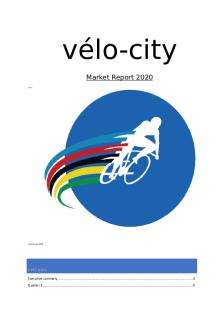MKTG206 revision 1 - Summary Marketing Simulation PDF

| Title | MKTG206 revision 1 - Summary Marketing Simulation |
|---|---|
| Course | Marketing Simulation |
| Institution | Lancaster University |
| Pages | 4 |
| File Size | 102.5 KB |
| File Type | |
| Total Downloads | 107 |
| Total Views | 168 |
Summary
Revision of the module for summer exam...
Description
Sunday, 24 January 2016
MKTG206: Test I Revision Overview of the MarkStrat World Products Sonite
Vodite
Processing Power
Resolution
Display Size
Energy Efficiency - using less without offsetting performance and convenience
Design Index
Carbon Footprint - emissions released during production, its decrease increases unit production costs
Battery Life
Connectivity
Features
Apps
- Base cost = the cost at which each unit is produced based on 100,000 units. - MD focus = margins and profitability; R&D focus = product feasibility Customers Sonite
Vodite
Explorers - high market interest, extremely knowledgable, high-performance, quite pricesensitive
Innovators - initial adopters, risk takers, low market share, high market interest, above average income
Shoppers - price/ product comparisons, high quality-price ration, average performance and convenience
Early Adopters - market influencers (opinion leaders, support adv), average income
Professionals - high quality and performance, ease of use, quality indicated by price
Followers - lower risk propensity, influenced by the above, below average income
High Earners - consumption motivated by social status, performance and convenience Savers - low cost and performance, average convenience
Distribution Channels
- Speciality Stores - high service levels, vodite preference - Mass Merch - low-price/ high-volume, low service, vodites to avoid in the early days, 10% discount promos
- Online Stores - popular for shoppers (convenience/ comparable), high growth potential, 5% discount promos
1
Sunday, 24 January 2016 Inflation rate = 2% average per period; economy growing at an average of 4% a period
Managing Your Firm - Decision mechanisms: product portfolio; segmentation/ positioning (via advertising + R&D); marketing mix (operational - pricing production, comms + channels).
- Performance measured by SPI (accounts for sales, market shares, revenues, R&D). - Production volume factors (units): forecasted sales, existing inventory, production team flexibility (+/- 20%).
- Transfer cost = the costs associated with production paid by marketing to production. Usually equal to base cost (based on 100k units). Inventory costs are calculated as a % of TC - info found in the newsletter. Will decrease for unit orders of...
Similar Free PDFs

Marketing Simulation Project
- 12 Pages

Marketing Principles Revision
- 37 Pages

Summary. June Jordan revision
- 2 Pages

Revision 1
- 13 Pages

RAS Revision Summary Book real
- 29 Pages

Summary - Revision Notes on Parties
- 12 Pages
Popular Institutions
- Tinajero National High School - Annex
- Politeknik Caltex Riau
- Yokohama City University
- SGT University
- University of Al-Qadisiyah
- Divine Word College of Vigan
- Techniek College Rotterdam
- Universidade de Santiago
- Universiti Teknologi MARA Cawangan Johor Kampus Pasir Gudang
- Poltekkes Kemenkes Yogyakarta
- Baguio City National High School
- Colegio san marcos
- preparatoria uno
- Centro de Bachillerato Tecnológico Industrial y de Servicios No. 107
- Dalian Maritime University
- Quang Trung Secondary School
- Colegio Tecnológico en Informática
- Corporación Regional de Educación Superior
- Grupo CEDVA
- Dar Al Uloom University
- Centro de Estudios Preuniversitarios de la Universidad Nacional de Ingeniería
- 上智大学
- Aakash International School, Nuna Majara
- San Felipe Neri Catholic School
- Kang Chiao International School - New Taipei City
- Misamis Occidental National High School
- Institución Educativa Escuela Normal Juan Ladrilleros
- Kolehiyo ng Pantukan
- Batanes State College
- Instituto Continental
- Sekolah Menengah Kejuruan Kesehatan Kaltara (Tarakan)
- Colegio de La Inmaculada Concepcion - Cebu









